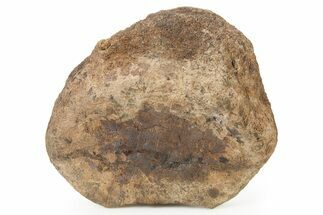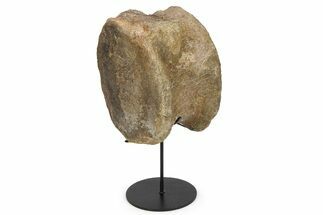This Specimen has been sold.
33" Ceratopsian (Triceratops?) Squamosal Bone - Hell Creek Formation
Note: Because of its size and weight, this piece will ship via freight on a pallet or in a crate. Our website can’t automatically calculate freight charges, so shipping costs will be determined and billed after purchase. If you’d like a quote beforehand, please contact us prior to ordering.
This is a spectacular, 32.8" Squamosal (back of skull) bone of a Ceratopsian dinosaur from the Hell Creek Formation of Montana. The squamosal bone makes up the posterior-lateral side of the skull and is the proximal edge of the frill.
Two Hell Creek experts who have looked at it thought the surface texture was different than most Triceratops they'd seen and suggested it might be Torosaurus or another ceratopsian. To me the shape appears to match Triceratops more than the squamosals of other Ceratopsians known from the Hell Creek Formation.
It is incredibly well preserved with just a few crack repairs and minor gap fill restoration. Great surface preservation with almost no weathering. On its stand, this is a very striking display.
About Triceratops
Triceratops is one of the most recognized and intriguing of the North American ceratopsid dinosaurs. They stomped around the Late Cretaceous (around 68-66 mya), brandishing their three-pronged and bony frilled skulls, chewing on fibrous plants. They struggled against large predators, stood their ground, and tried not to be devoured by the ferocious Tyrannosaurus rex.
The head on a Triceratops may have been an intimidating show rather than a stabbing, defensive trident and imposing shield for inter-species jousting. Researchers have given close scrutiny to the holes, or fenestrae, of other ceratopsid crests. In the past, the holes within the shield were used to confirm separate species.
Individual Triceratops are estimated to have reached up to 9 meters (29.5 feet) in length, 3 meters (9.8 feet) in height, and weighed up to 26,000 pounds. The largest known skull is estimated to have been 2.5 meters (8.2 feet) long and would have extended almost a third of the length of the mature individual. The pointed horns were approximately 1 meter (3 feet) long. With its sturdy build and powerful legs, Triceratops could have ripped open the predator that wanted this herbivore for dinner.
One of the most abundant of the large Cretaceous fauna, Triceratops plucked low growth with its beak-tipped jaws. Triceratops teeth were arranged in groups, called batteries, of 36 to 40 tooth columns, in each side of each jaw. Each column contained about 3 to 5 stacked teeth, depending on the individual’s size. This produced a range of 432 to 800 teeth, of which only a fraction were in use at any given time (due to tooth replacement). The great size and quantity of teeth suggests that they ate large volumes of fibrous plants. These were possibly palms, cycads, and ferns.
Triceratops was designated as the state fossil of South Dakota in 1988.
Triceratops is one of the most recognized and intriguing of the North American ceratopsid dinosaurs. They stomped around the Late Cretaceous (around 68-66 mya), brandishing their three-pronged and bony frilled skulls, chewing on fibrous plants. They struggled against large predators, stood their ground, and tried not to be devoured by the ferocious Tyrannosaurus rex.
The head on a Triceratops may have been an intimidating show rather than a stabbing, defensive trident and imposing shield for inter-species jousting. Researchers have given close scrutiny to the holes, or fenestrae, of other ceratopsid crests. In the past, the holes within the shield were used to confirm separate species.
Individual Triceratops are estimated to have reached up to 9 meters (29.5 feet) in length, 3 meters (9.8 feet) in height, and weighed up to 26,000 pounds. The largest known skull is estimated to have been 2.5 meters (8.2 feet) long and would have extended almost a third of the length of the mature individual. The pointed horns were approximately 1 meter (3 feet) long. With its sturdy build and powerful legs, Triceratops could have ripped open the predator that wanted this herbivore for dinner.
One of the most abundant of the large Cretaceous fauna, Triceratops plucked low growth with its beak-tipped jaws. Triceratops teeth were arranged in groups, called batteries, of 36 to 40 tooth columns, in each side of each jaw. Each column contained about 3 to 5 stacked teeth, depending on the individual’s size. This produced a range of 432 to 800 teeth, of which only a fraction were in use at any given time (due to tooth replacement). The great size and quantity of teeth suggests that they ate large volumes of fibrous plants. These were possibly palms, cycads, and ferns.
Triceratops was designated as the state fossil of South Dakota in 1988.
The Hell Creek Formation
Renowned for both its age and rich sedimentary layers, the Hell Creek Formation is one of the most intensively studied fossil-bearing regions on Earth. To date, scientists have documented 158 genera of animals and 64 genera of plants from its rocks, with new finds emerging regularly. Beyond iconic dinosaurs such as tyrannosaurs, ceratopsians, and hadrosaurs, the formation has produced an extraordinary array of life, including amphibians, reptiles, lizards, snakes, turtles, fish, sharks, birds, and early mammals. Together, these fossils provide the most complete picture of the ecosystems that thrived just before the Cretaceous–Paleogene extinction event.
Renowned for both its age and rich sedimentary layers, the Hell Creek Formation is one of the most intensively studied fossil-bearing regions on Earth. To date, scientists have documented 158 genera of animals and 64 genera of plants from its rocks, with new finds emerging regularly. Beyond iconic dinosaurs such as tyrannosaurs, ceratopsians, and hadrosaurs, the formation has produced an extraordinary array of life, including amphibians, reptiles, lizards, snakes, turtles, fish, sharks, birds, and early mammals. Together, these fossils provide the most complete picture of the ecosystems that thrived just before the Cretaceous–Paleogene extinction event.
SPECIES
Triceratops?
LOCATION
Slope County, North Dakota
FORMATION
Hell Creek Formation
SIZE
32.8" long
CATEGORY
SUB CATEGORY
ITEM
#113110
We guarantee the authenticity of all of our specimens.
 Reviews
Reviews



















